Gas-Flow-Rate Inversion Based on Experiments and Simulation of Flame Combustion Characteristics in a Drilling Blowout
Abstract
:1. Introduction
2. Model Establishment and Validation
2.1. Mathematical Model
2.1.1. Control Equations
- (1)
- Mass conservation equationwhere ui (i = x, y, z) is the velocity component, in m/s.
- (2)
- Momentum conservation equationsThe momentum equations in the x, y, and z directions are given aswhere τii (i = x, y, z) is the component of viscous stress, and Pa; fi(i = x, y, z) is the unit mass force component, in m/s−2.
- (3)
- Energy conservation equationwhere Keff is effective thermal conductivity, W·m−1·K−1; h is enthalpy, J kg−1, and enthalpy J is diffusion flux.
- (4)
- Component transport equation
2.1.2. Turbulence Model
2.1.3. Boundary Conditions and Solution Method
2.2. Model Verification
3. Simulation Analysis of Jet Flame Combustion Characteristics under Blowout Conditions
3.1. Blowout Fire Physical Model
3.2. Effects of Wind Speed on the Combustion Characteristics of Blowout Jet Flames
- (1)
- Effects of wind speed on the flame temperature field
- (2)
- Effects of wind speed on the flame radiation field
- (3)
- Effects of wind speed on flame height
3.3. Effects of Blowout Gas Flow Rate on Blowout Jet Flame
- (1)
- Effects of blowout gas flow rate on flame temperature field
- (2)
- Effects of blowout gas flow rate on flame radiation field
- (3)
- Effects of blowout gas flow rate on flame height
3.4. Wellhead Size Effects on Blowout Jet Flame
- (1)
- Effects of wellhead diameter on flame temperature field
- (2)
- Effects of wellhead diameter on flame radiation field
- (3)
- Effects of wellhead diameter on flame height
4. Prediction Methods for Gas Flow Rate at the Wellhead under Blowout Conditions
- (1)
- Prediction method for gas flow rate at the wellhead based on jet flame height
- (2)
- Prediction method for gas flow rate at the wellhead based on the thermal radiation intensity of the flame
- (3)
- Optimal prediction method for blowout gas volume
5. Conclusions
- Based on the characteristics of multicomponent gas and the turbulent state at the wellhead flame, a mathematical model that includes component transport and turbulent equations was established. Considering the under-expanded jet flow at the nozzle, a “virtual nozzle” was proposed to simplify the complex flow. Accordingly, a computational model of the blowout jet flame was established using FLUENT software 2021r2. The accuracy of the blowout jet flame calculation model was verified with experimental data, where errors for the simulated flame height, temperature, and thermal radiation were 8.91%, 16.94%, and 9.54%, respectively.
- A comparative analysis of the results obtained under different wind speeds, blowout gas volumes, and wellhead diameters revealed the effects of various external factors on the thermal radiation range of blowout jet fire accidents and the variation law of flame morphology. The jet flame height and thermal radiation intensity were positively correlated with the blowout gas volume, and the maximum temperature of the blowout jet flame was independent of the blowout gas volume. The wellhead diameter had little effect on the shape of the blowout jet flame of high-yield gas wells, where all were slender and elongated; under the same conditions, the longer the wellhead diameter, the higher was the flame height.
- Two prediction methods for blowout gas volume were proposed: an empirical formula based on flame height and an analytical model based on flame radiation. A comparison of the errors of the two methods in experimental data calculations revealed that the error for predicting the blowout gas volume using the blowout jet flame height was 7.75%, which proved simpler and more accurate than when predicting the blowout gas volume using flame radiation.
Author Contributions
Funding
Data Availability Statement
Conflicts of Interest
Nomenclature
| c | Volume fraction |
| fi (i = x, y, z) | Unit mass force component, m·s−2 |
| h | Enthalpy, J kg−1 |
| p | Pressure, Pa |
| q″ | Radiant heat flux, kW·m−2 |
| ui (i = x, y, z) | Velocity component, m·s−1 |
| u1 | Gas velocity at the wellhead, m·s−1 |
| u2 | Equivalent gas velocity at the virtual nozzle, m·s−1 |
| A2 | Equivalent area at the virtual nozzle, m2 |
| Cε1, Cε2 | Constant, Cε1 = 1.44, Cε2 = 1.9 |
| Cε3 | Constant, Shear flow with flow velocity in the same direction as gravity where Cε3 = 1; Shear flow perpendicular to the direction of gravity, where Cε3 = 0 |
| D | Diffusion coefficient |
| E | Energy, J kg−1 |
| Gb | Turbulent kinetic energy term generated by buoyancy |
| Gk | Turbulent kinetic energy term generated by mean velocity |
| J | Diffusion flux |
| Keff | Effective thermal conductivity, W·m−1·K−1 |
| P2 | Pressure of gas at the virtual nozzle, Pa |
| Q | Mass flow rate, kg·s−1 |
| RT | Distance from the target object to the point source, m |
| S | Generation rate |
| Sh | Volumetric heat source term of the fluid and part where the fluid converts its chemical and mechanical energy into thermal energy under viscous effects |
| Xg | Radiative heat fraction, where Xg = 0.2 |
| Ym | Ratio of turbulent kinetic energy associated with fluctuating expansion in compressible turbulent flows to the total dissipation rate |
| ∆H | Methane combustion heat value, where ∆H = 52 × 103 kJ·kg−1 |
| ρ | Fluid density, kg·m−3 |
| ρa | Gas density at the wellhead, kg·m−3 |
| ρ2 | Equivalent gas density at the virtual nozzle, kg·m−3 |
| τi (i = x, y, z) | Component of viscous stress, Pa |
| σk | Turbulent kinetic energy corresponding to the Prandtl number, where σk = 1.0 |
| σε | Prandtl number corresponding to the turbulent dissipation rate, where σε = 1.3 |
| λ | Atmospheric transmittance, where λ = 1 |
References
- Suris, A.L.; Flankin, E.V.; Shorin, S.N. Length of free diffusion flames. Combust. Explos. Shock Waves 1978, 13, 459–462. [Google Scholar] [CrossRef]
- Røkke, N.A.; Hustad, J.E.; Sønju, O.K. A study of partially premixed unconfined propane flames. Combust. Flame 1994, 97, 88–106. [Google Scholar] [CrossRef]
- Costa, M.; Parente, C.; Santos, A. Nitrogen oxides emissions from buoyancy and momentum controlled turbulent methane jet diffusion flames. Exp. Therm. Fluid Sci. 2004, 28, 729–734. [Google Scholar] [CrossRef]
- Santos, A.; Costa, M. Reexamination of the scaling laws for NOx emissions from hydrocarbon turbulent jet diffusion flames. Combust. Flame 2005, 142, 160–169. [Google Scholar] [CrossRef]
- Kiran, D.Y.; Mishra, D.P. Experimental studies of flame stability and emission characteristics of simple LPG jet diffusion flame. Fuel 2007, 86, 1545–1551. [Google Scholar] [CrossRef]
- Palacios, A.; Muñoz, M.; Casal, J. Jet fires: An experimental study of the main geometrical features of the flame in subsonic and sonic regimes. AIChE J. 2009, 55, 256–263. [Google Scholar] [CrossRef]
- Zhou, K.; Liu, J.; Jiang, J. Prediction of radiant heat flux from horizontal propane jet fire. Appl. Therm. Eng. 2016, 106, 634–639. [Google Scholar] [CrossRef]
- Gopalaswami, N.; Liu, Y.; Laboureur, D.M.; Zhang, B.; Mannan, M.S. Experimental study on propane jet fire hazards: Comparison of main geometrical features with empirical models. J. Loss Prev. Process Ind. 2016, 41, 365–375. [Google Scholar] [CrossRef]
- Stfnju, O.K.; Hustadf, J. An Experimental Study of Turbulent Jet Diffusion Flames; British Maritime Technology: London, UK, 1983. [Google Scholar]
- Haas, L. Reprints available directly from the publisher Photocopying permitted by license only. Rev. Educ. Pedagog. Cult. Stud. 1995, 17, 1–6. [Google Scholar] [CrossRef]
- Bagster, D.F.; Schubach, S.A. The prediction of jet-fire dimensions. J. Loss Prev. Process Ind. 1996, 9, 241–245. [Google Scholar] [CrossRef]
- Imamura, T.; Hamada, S.; Mogi, T.; Wada, Y.; Horiguchi, S.; Miyake, A.; Ogawa, T. Experimental investigation on the thermal properties of hydrogen jet flame and hot currents in the downstream region. Int. J. Hydrogen Energy 2008, 33, 3426–3435. [Google Scholar] [CrossRef]
- Mogi, T.; Horiguchi, S. Experimental study on the hazards of high-pressure hydrogen jet diffusion flames. J. Loss Prev. Process Ind. 2009, 22, 45–51. [Google Scholar] [CrossRef]
- Palacios, A.; Casal, J. Assessment of the shape of vertical jet fires. Fuel 2011, 90, 824–833. [Google Scholar] [CrossRef]
- Bo, Z.; Shuang, L.; Pengcheng, W. Comparative analysis of the influence range and model of thermal radiation caused by blowout and jet fire. China Saf. Prod. Sci. Technol. 2022, 18, 139–144. [Google Scholar]
- Qihua, W.; Zhanwen, L.; Zhijiu, A. Simulation study on uncontrolled blowout and jet fire under different gas production rates. Saf. Environ. Eng. 2009, 16, 103–107. [Google Scholar]
- Mashhadimoslem, H.; Ghaemi, A.; Palacios, A.; Behroozi, A.H. A new method for comparison thermal radiation on large-scale hydrogen and propane jet fires based on experimental and computational studies. Fuel 2020, 282, 118864. [Google Scholar] [CrossRef]
- Li, G. Numerical simulation study on combustion characteristics of mixed fuels containing CO. Ph.D. Thesis, Beijing University of Technology, Beijing, China, 2010. [Google Scholar]
- Mashhadimoslem, H.; Ghaemi, A.; Behroozi, A.H.; Palacios, A. A New simplified calculation model of geometric thermal features of a vertical propane jet fire based on experimental and computational studies. Process Saf. Environ. Prot. 2020, 135, 301–314. [Google Scholar] [CrossRef]
- Kim, Y.S.; Jeon, J.; Song, C.H.; Kim, S.J. Improved prediction model for H2/CO combustion risk using a calculated non-adiabatic flame temperature model. Nucl. Eng. Technol. 2020, 52, 2836–2846. [Google Scholar] [CrossRef]
- Lowesmith, B.J.; Hankinson, G.; Acton, M.R.; Chamberlain, G. An Overview of the Nature of Hydrocarbon Jet Fire Hazards in the Oil and Gas Industry and a Simplified Approach to Assessing the Hazards. Process Saf. Environ. Prot. 2007, 85, 207–220. [Google Scholar] [CrossRef]
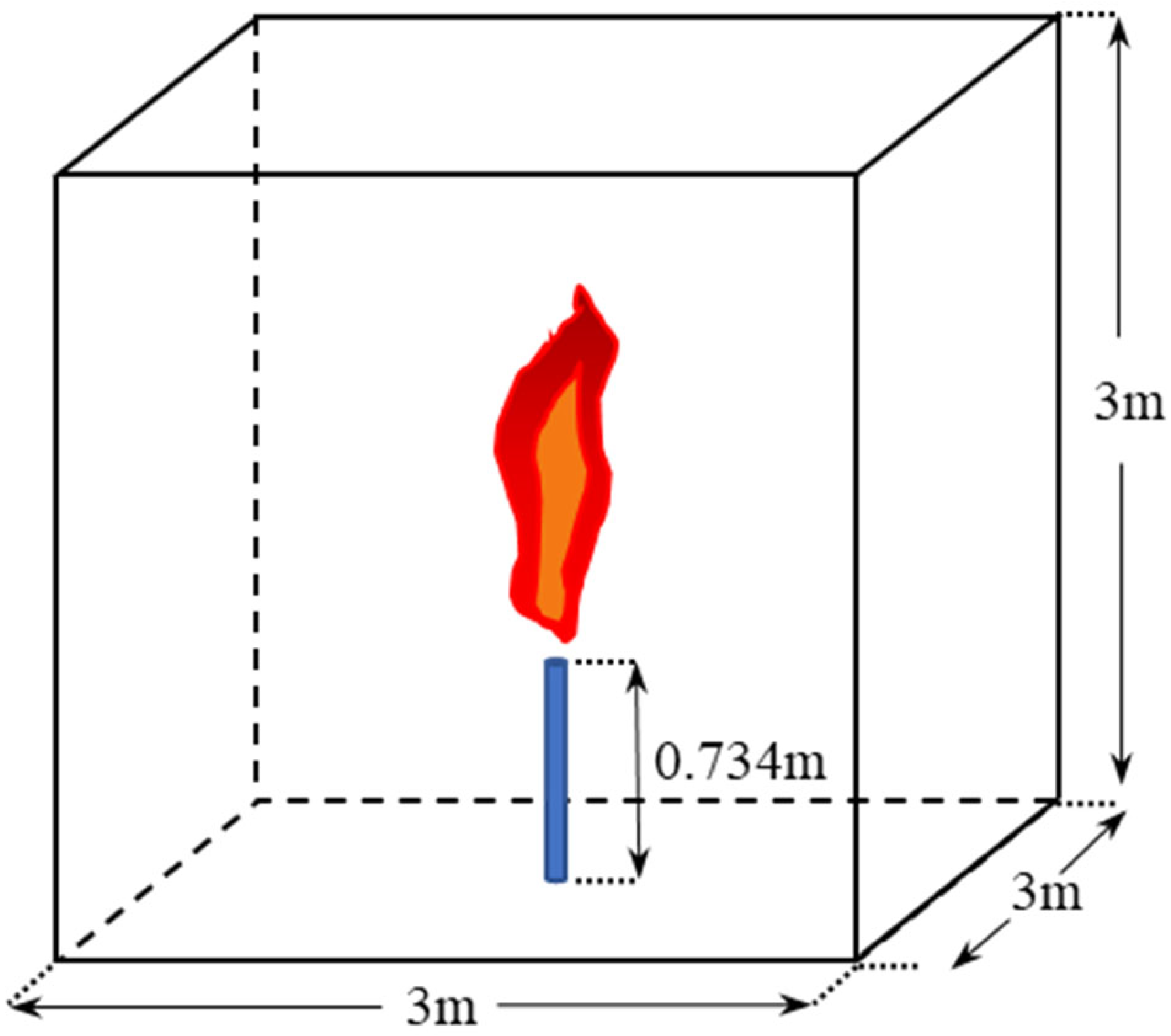
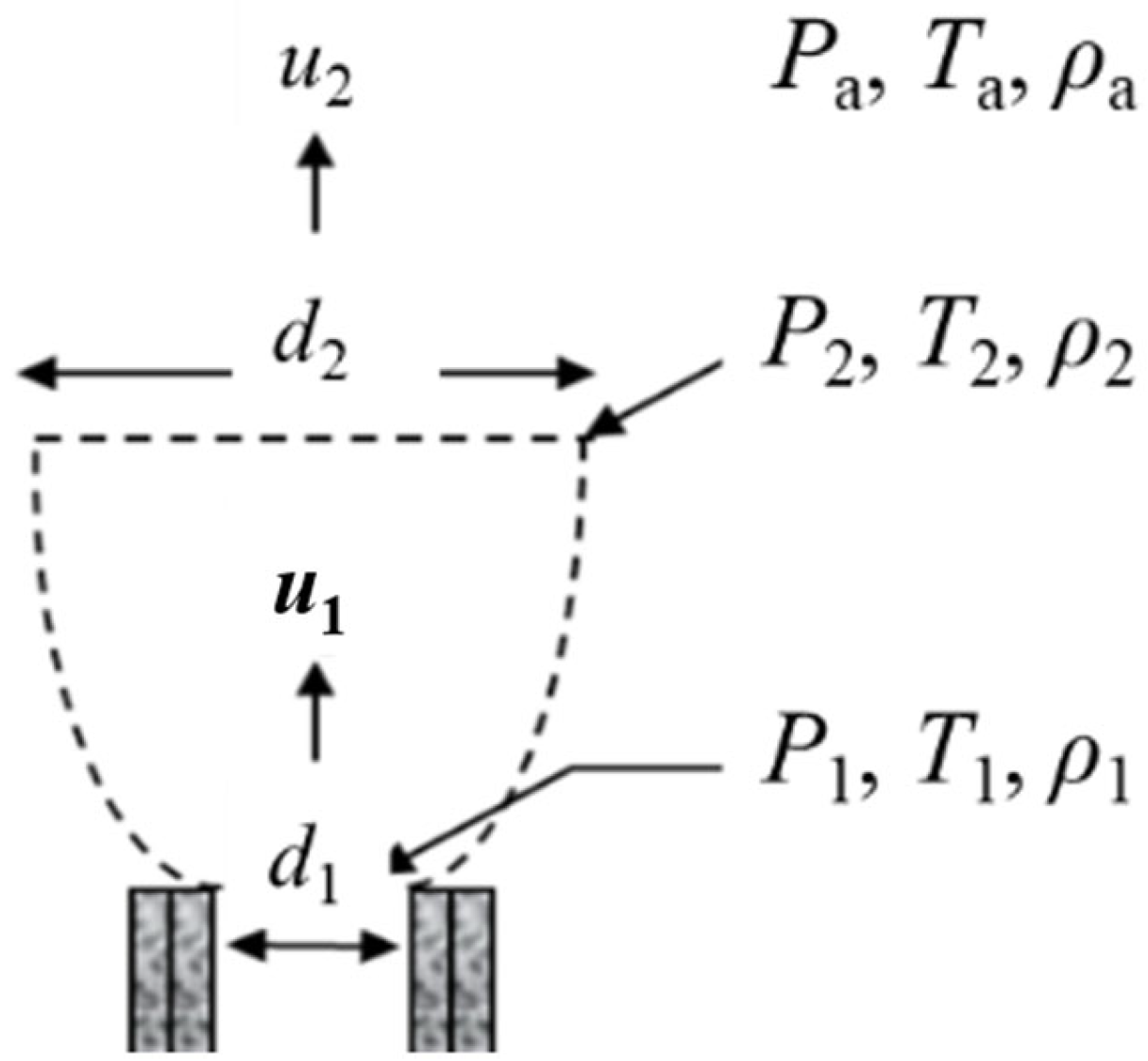
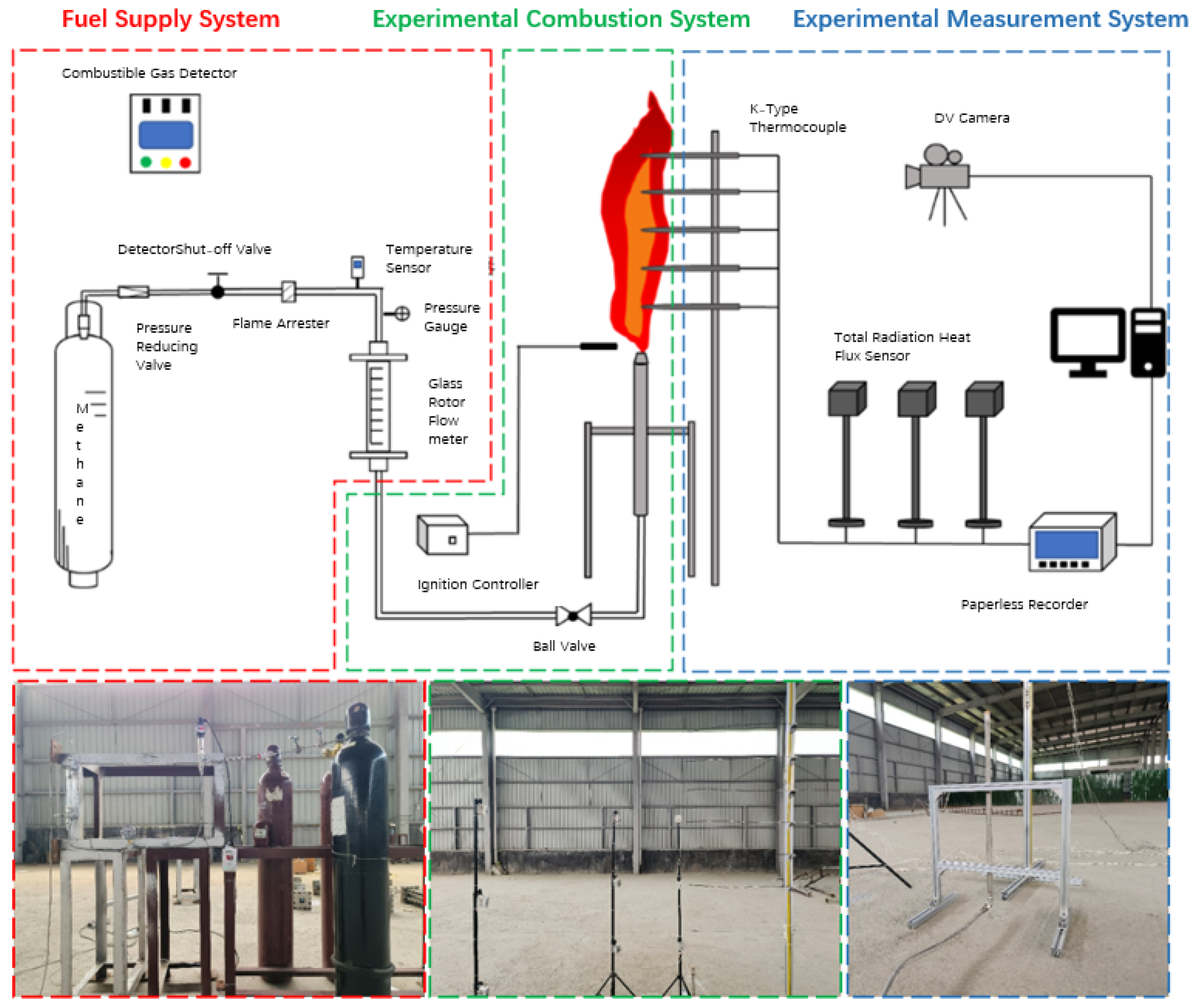
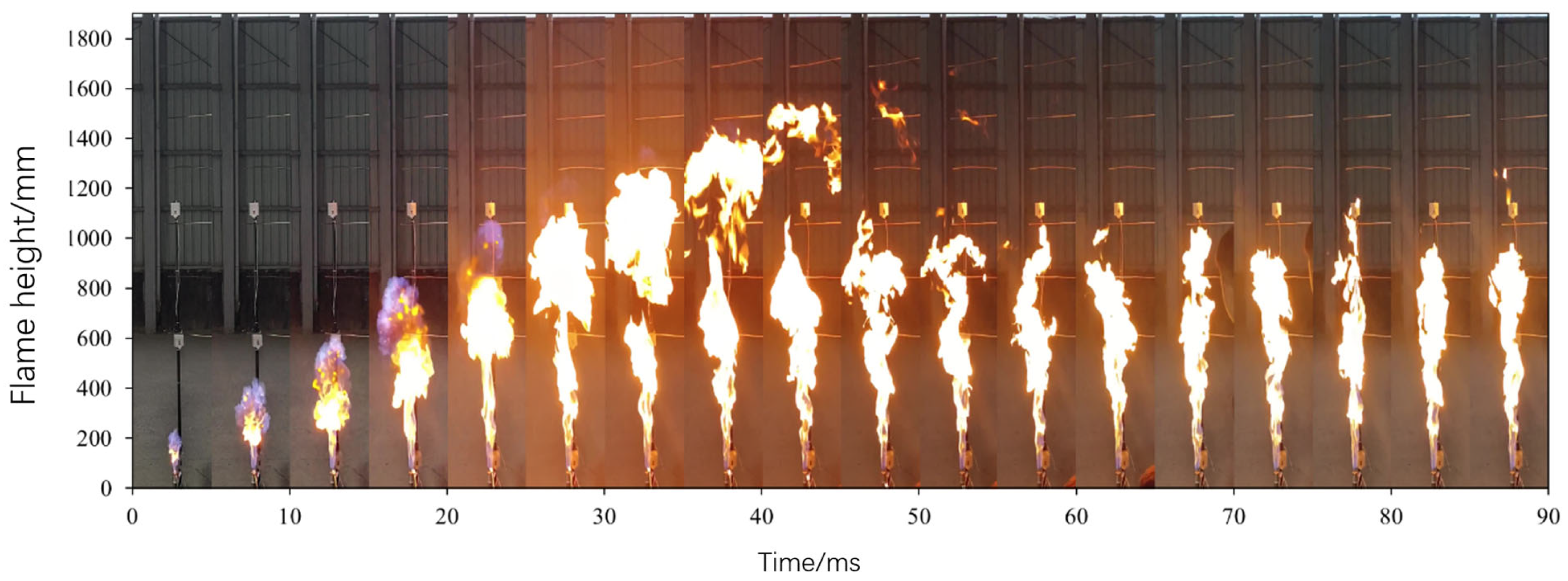
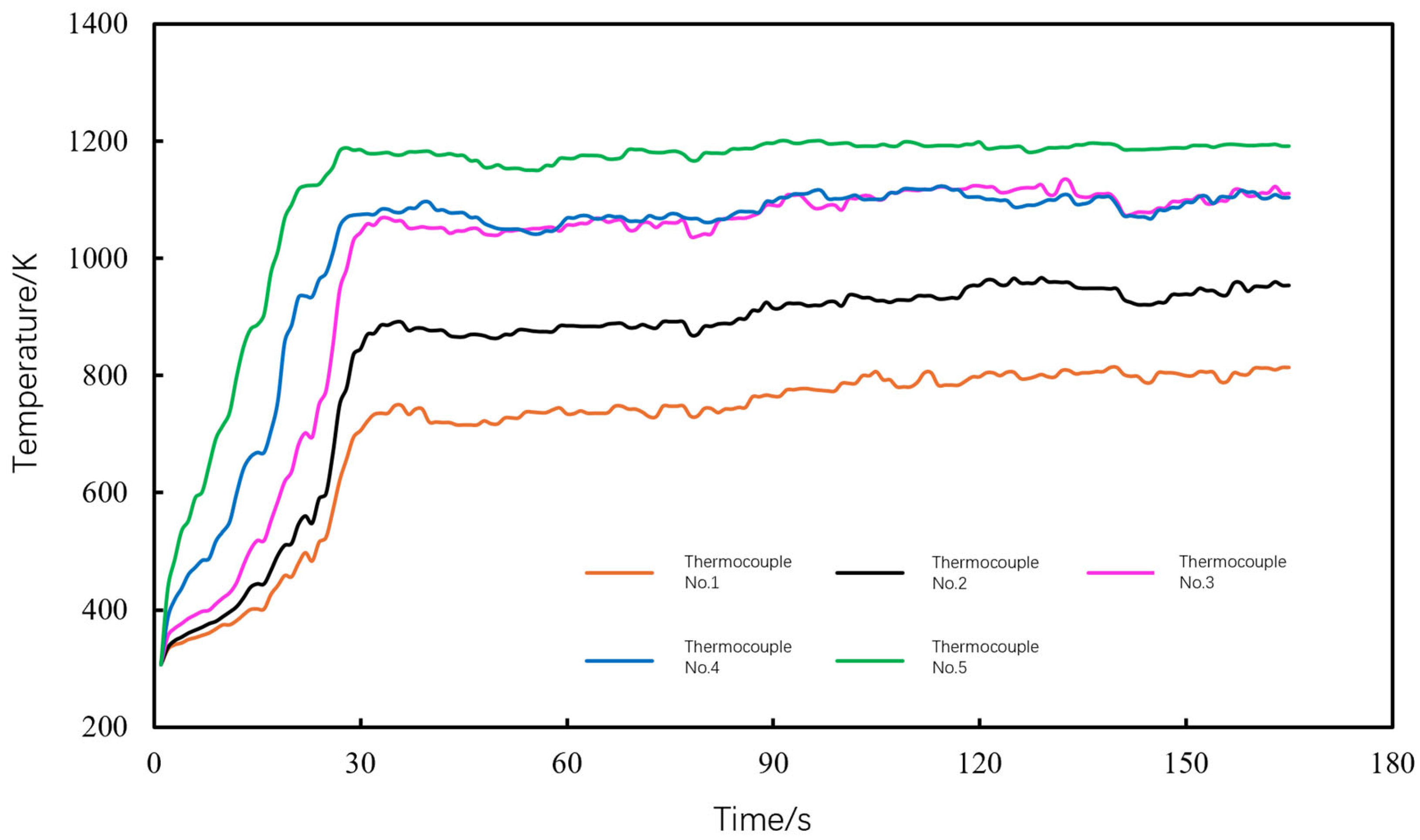


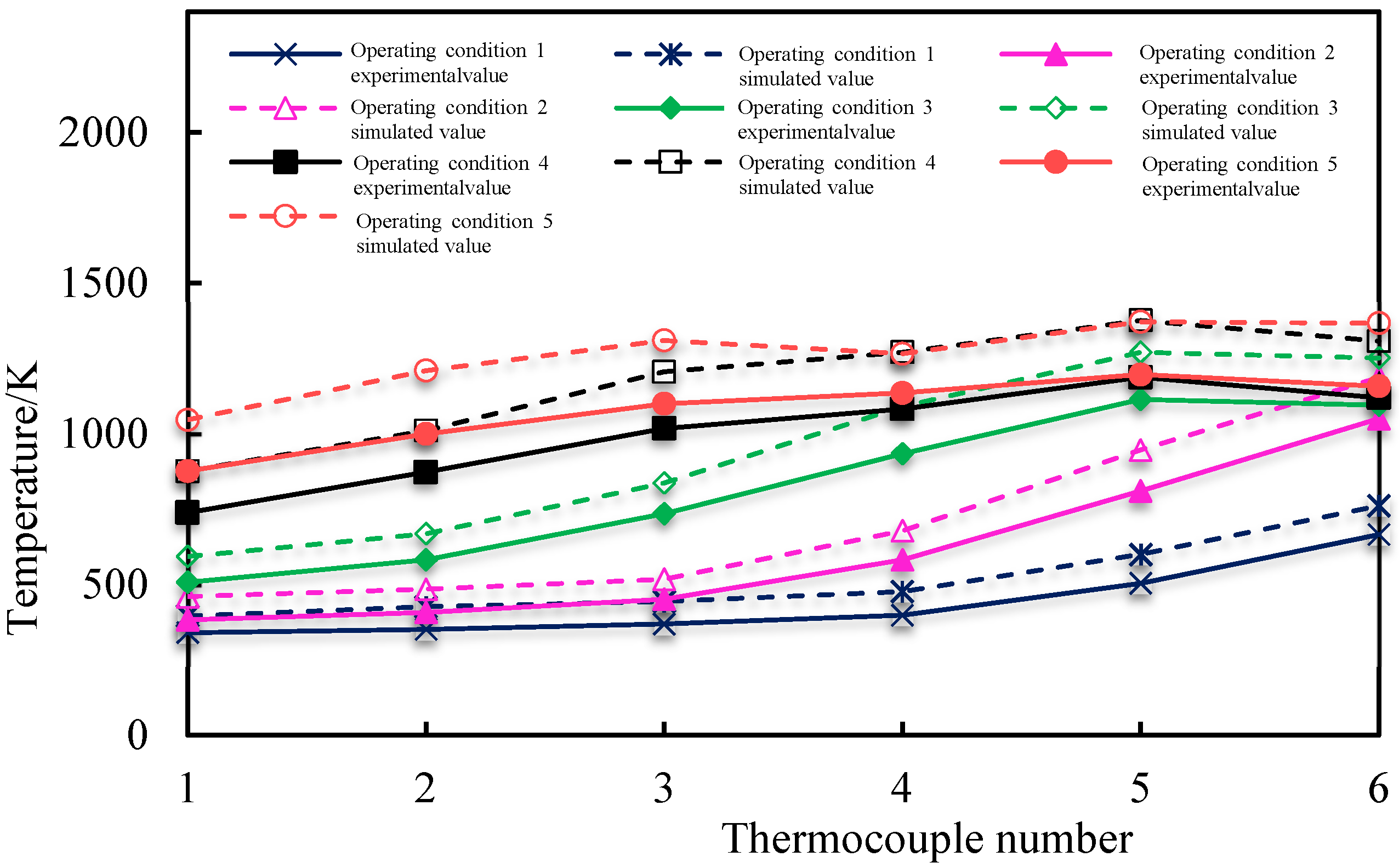
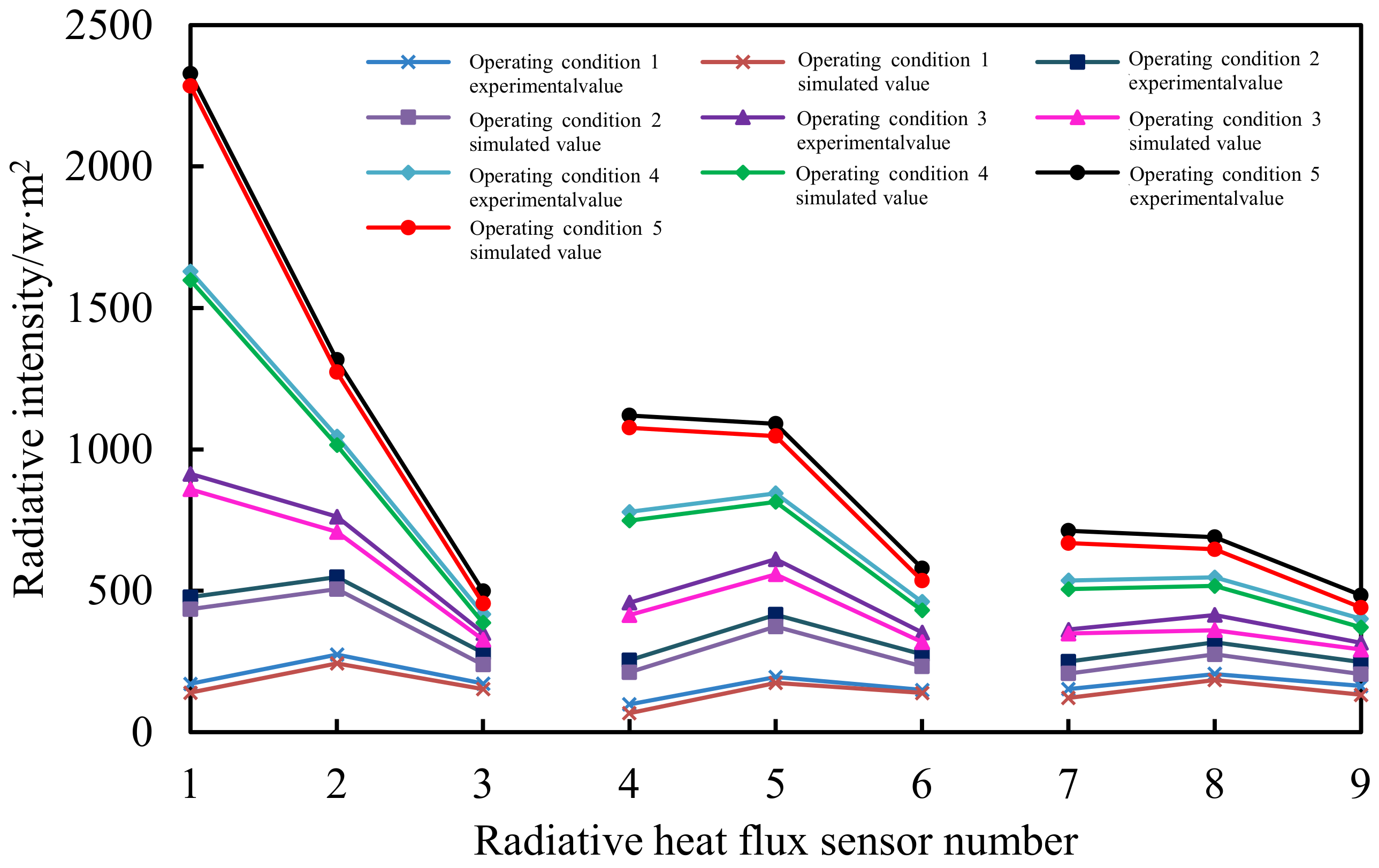
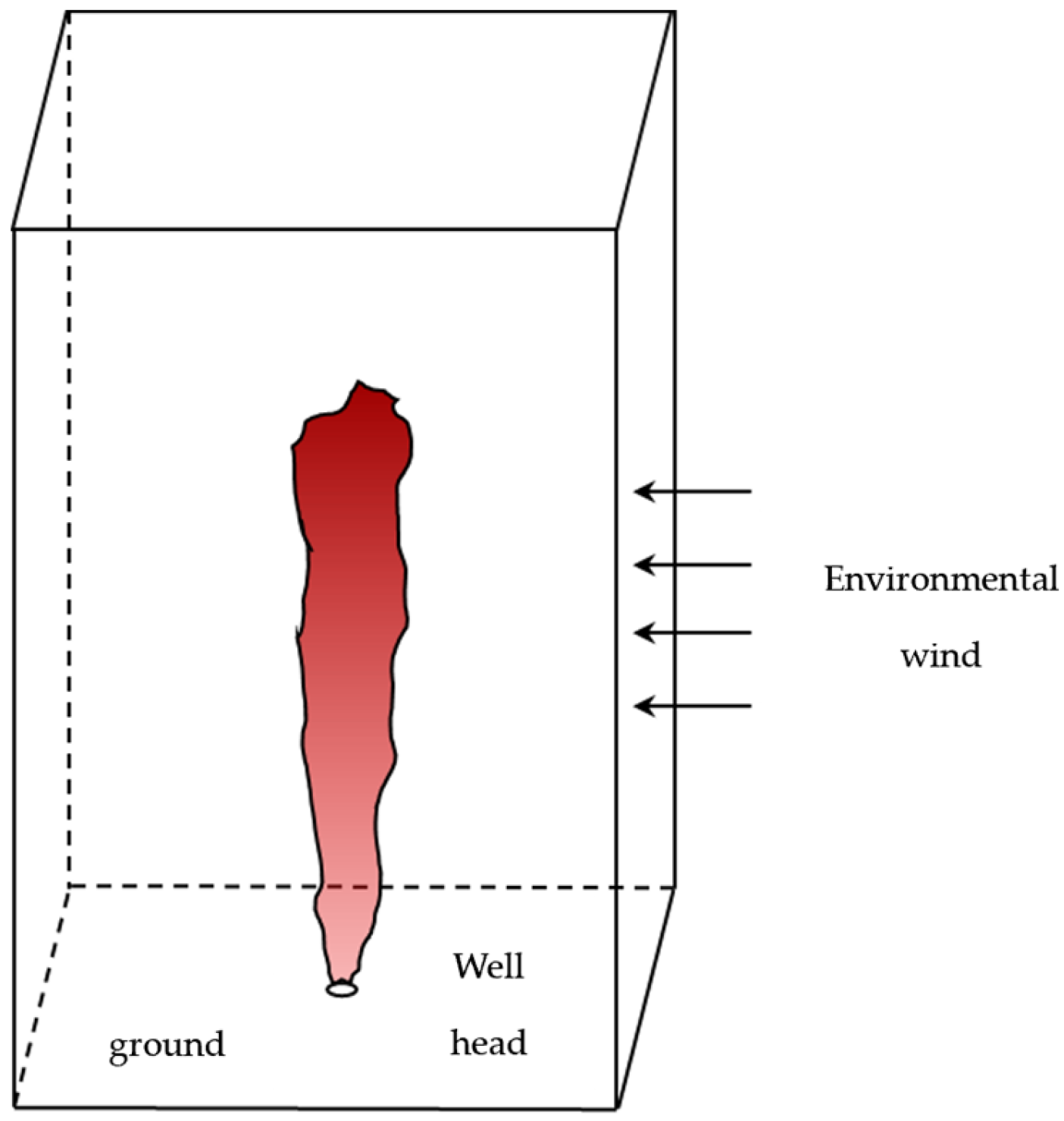

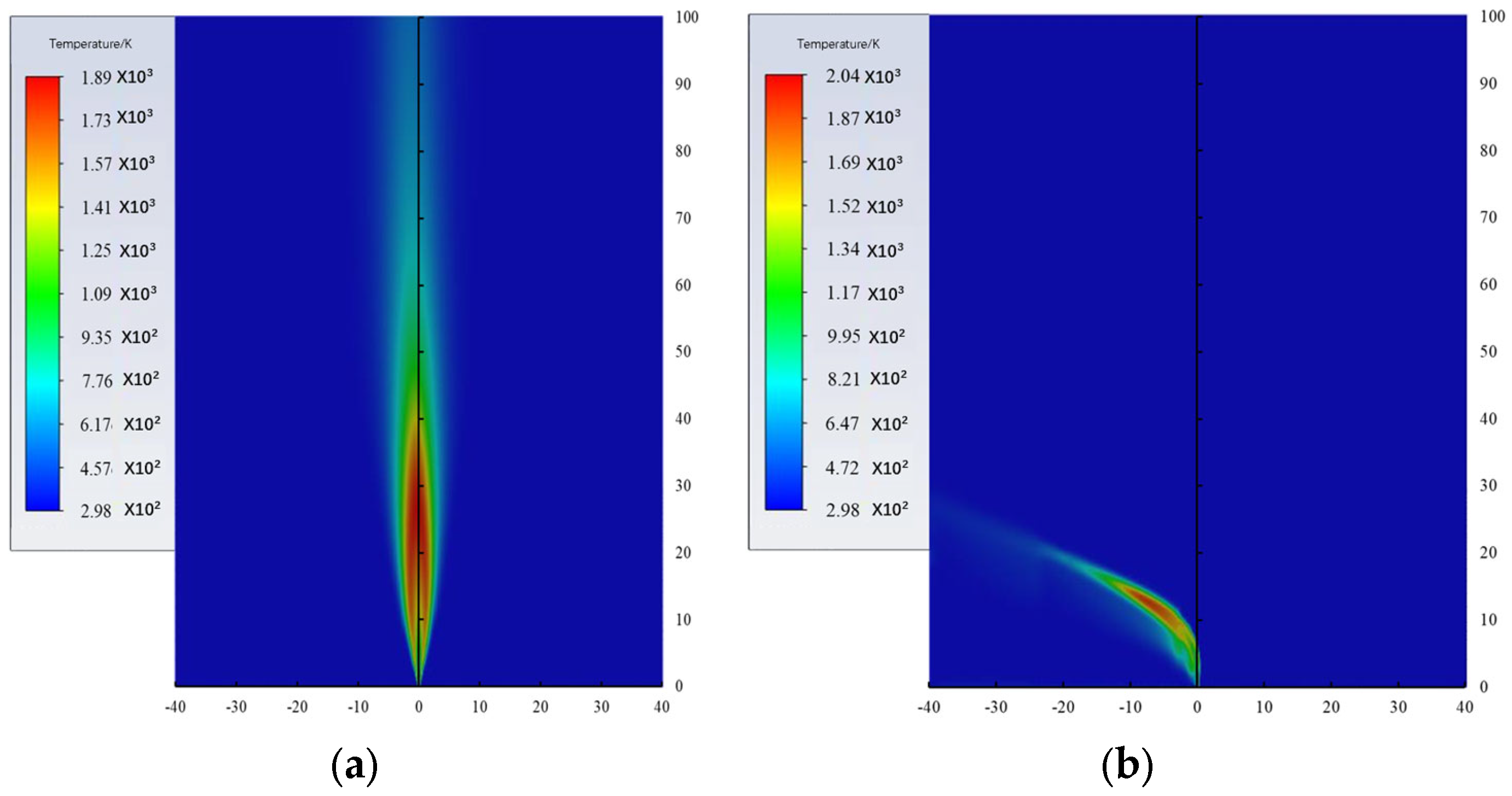
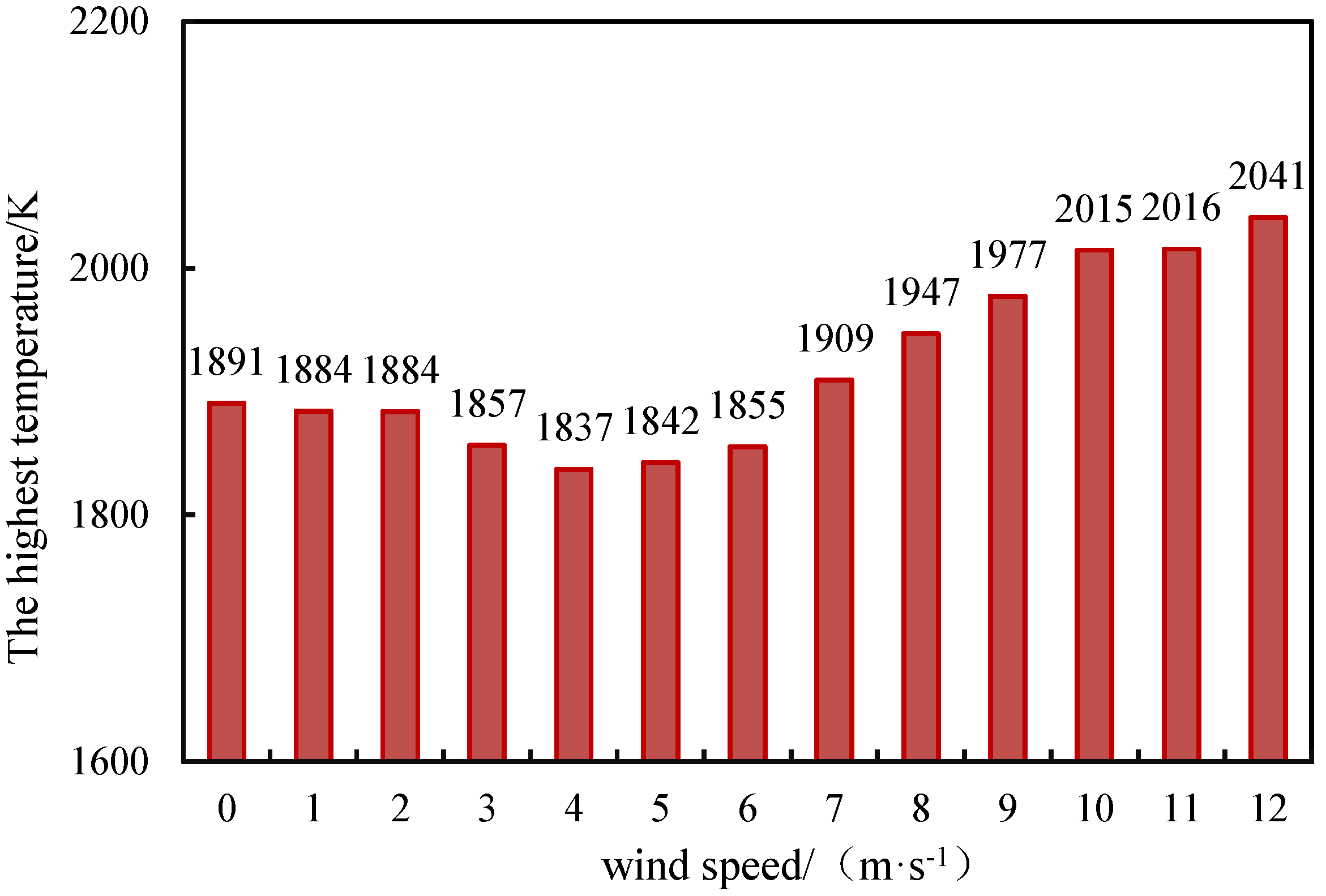
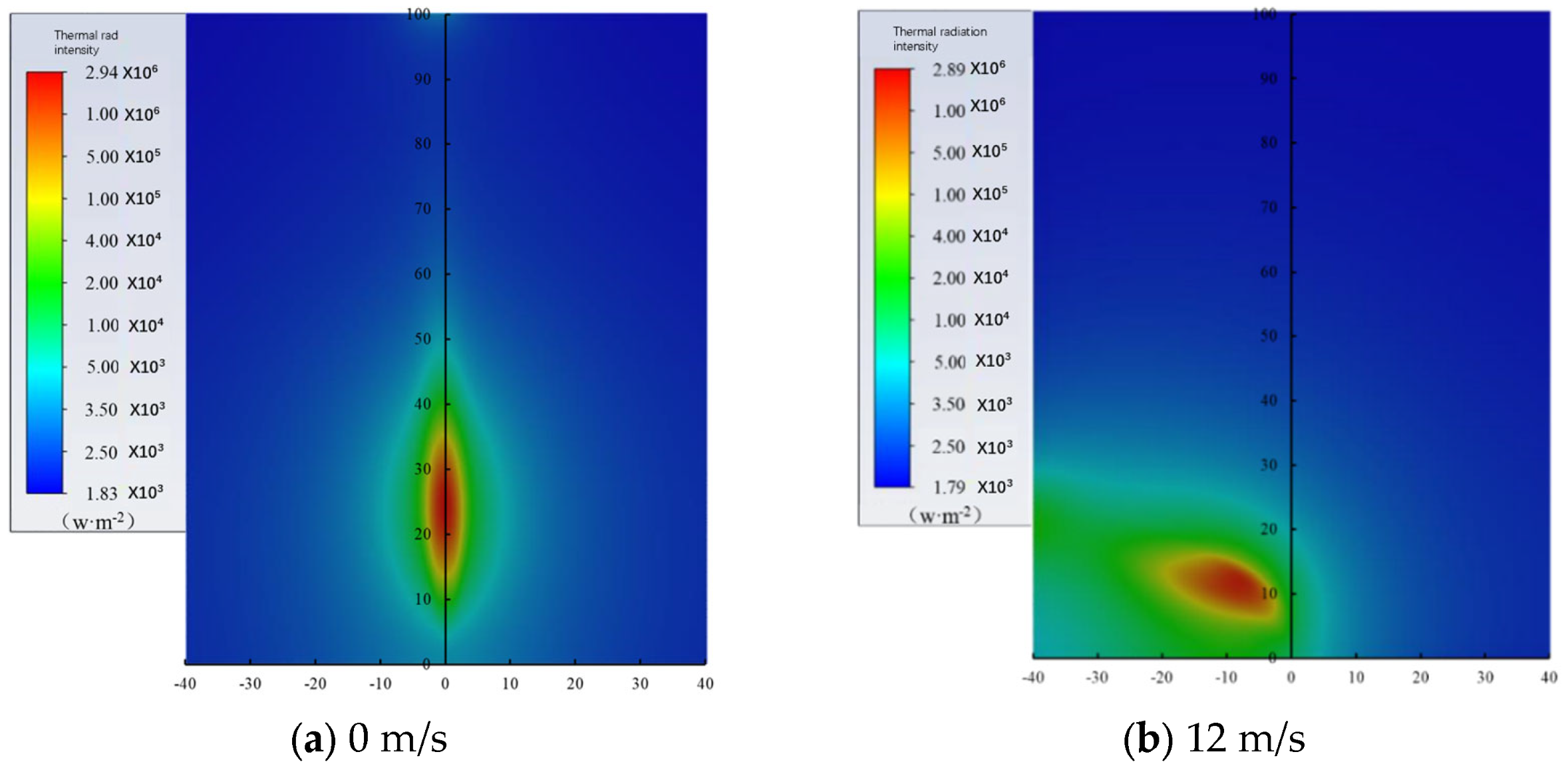
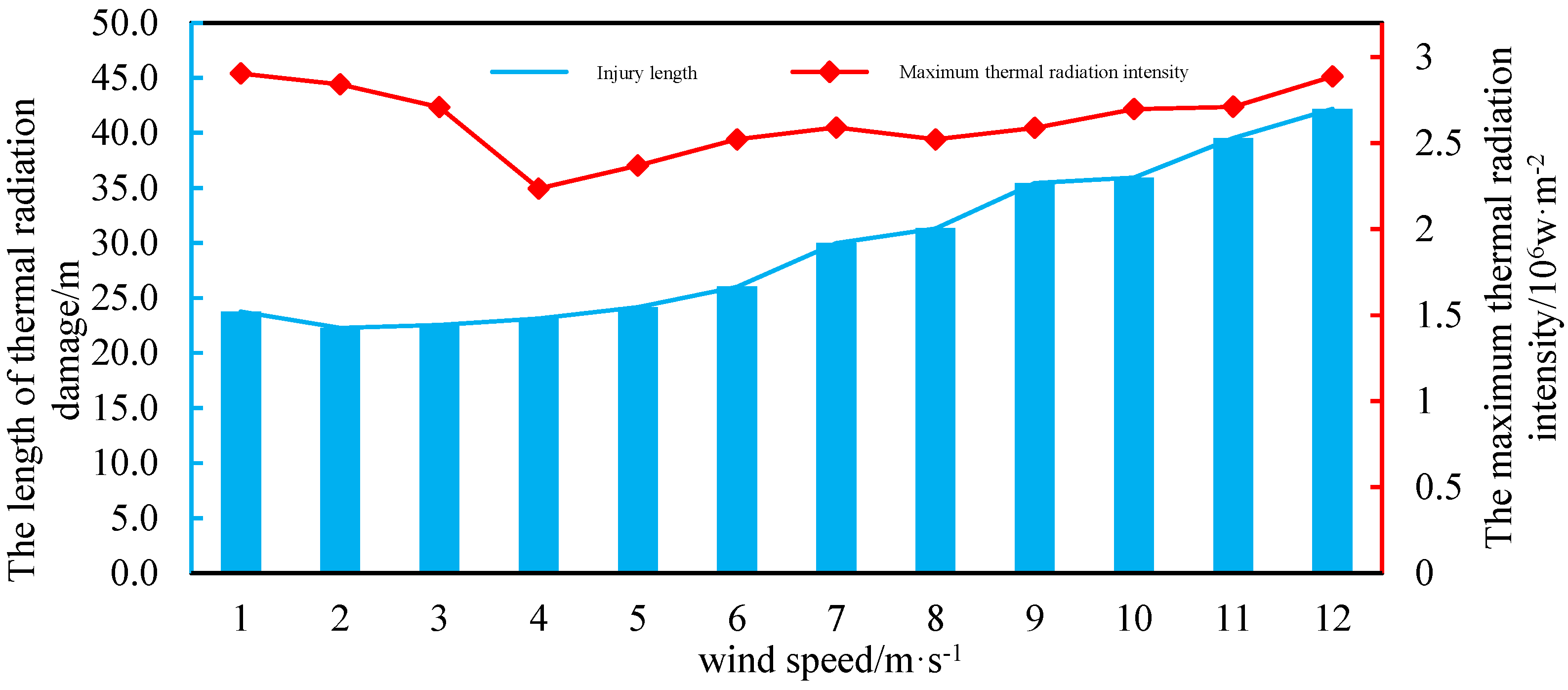
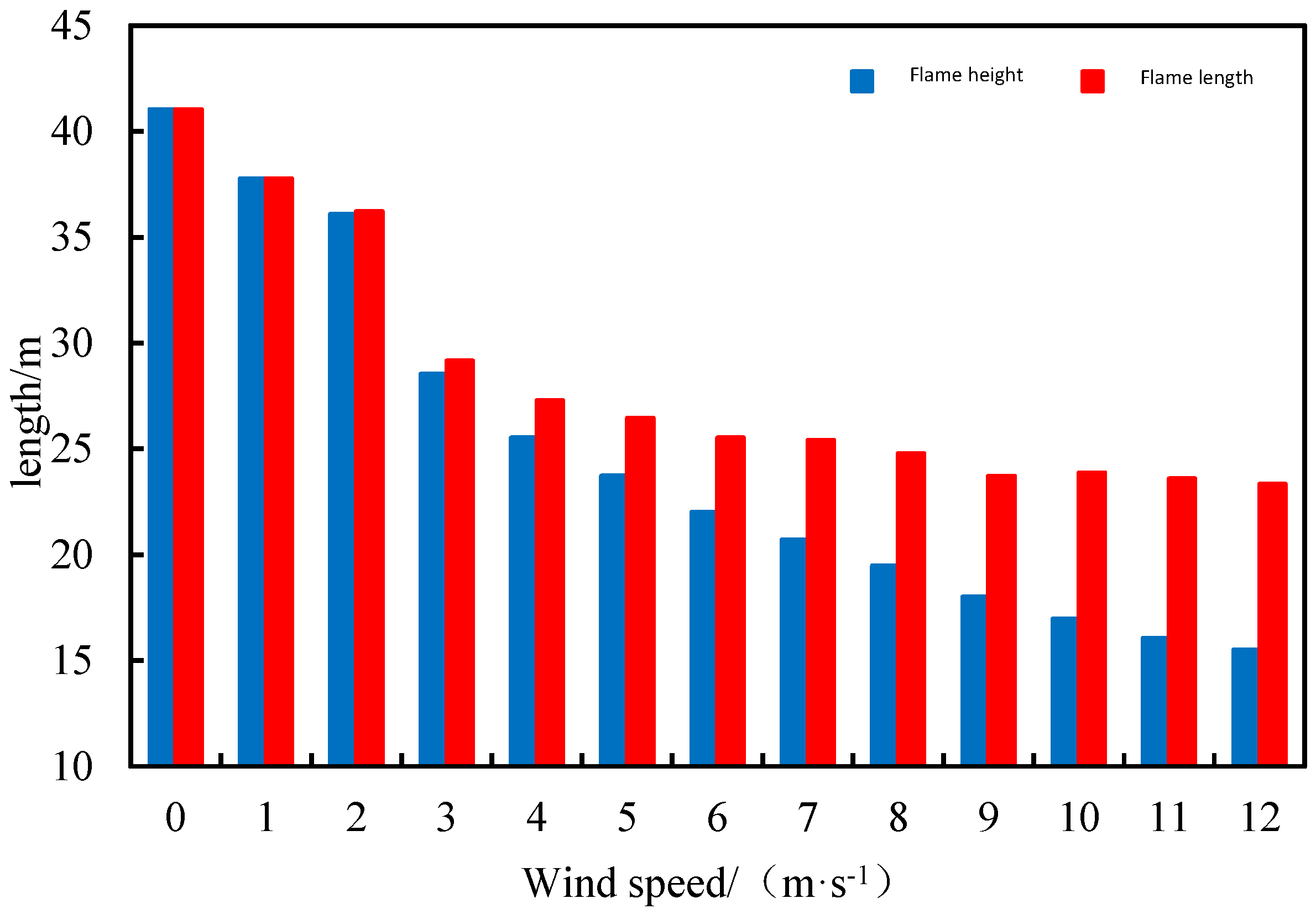
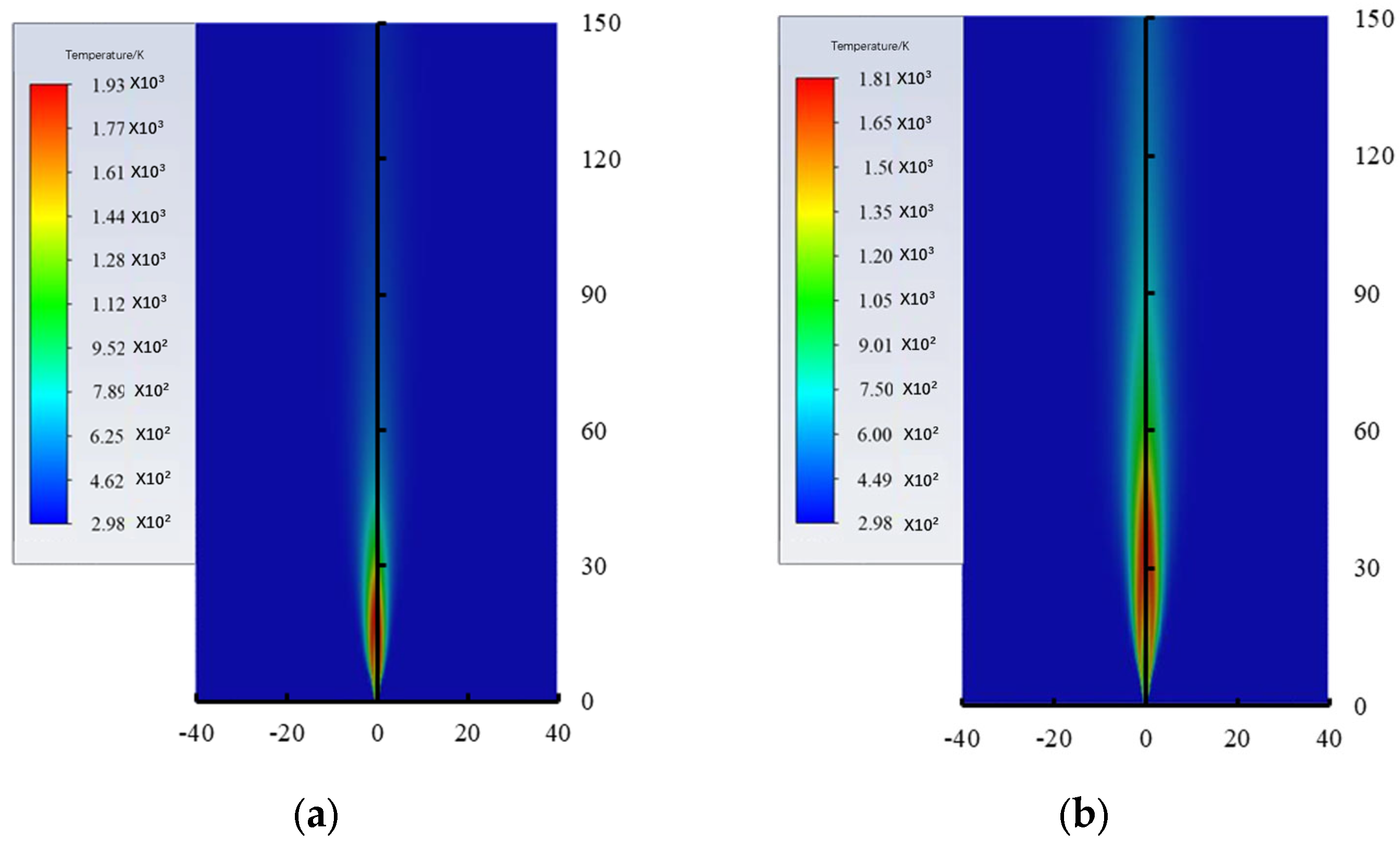
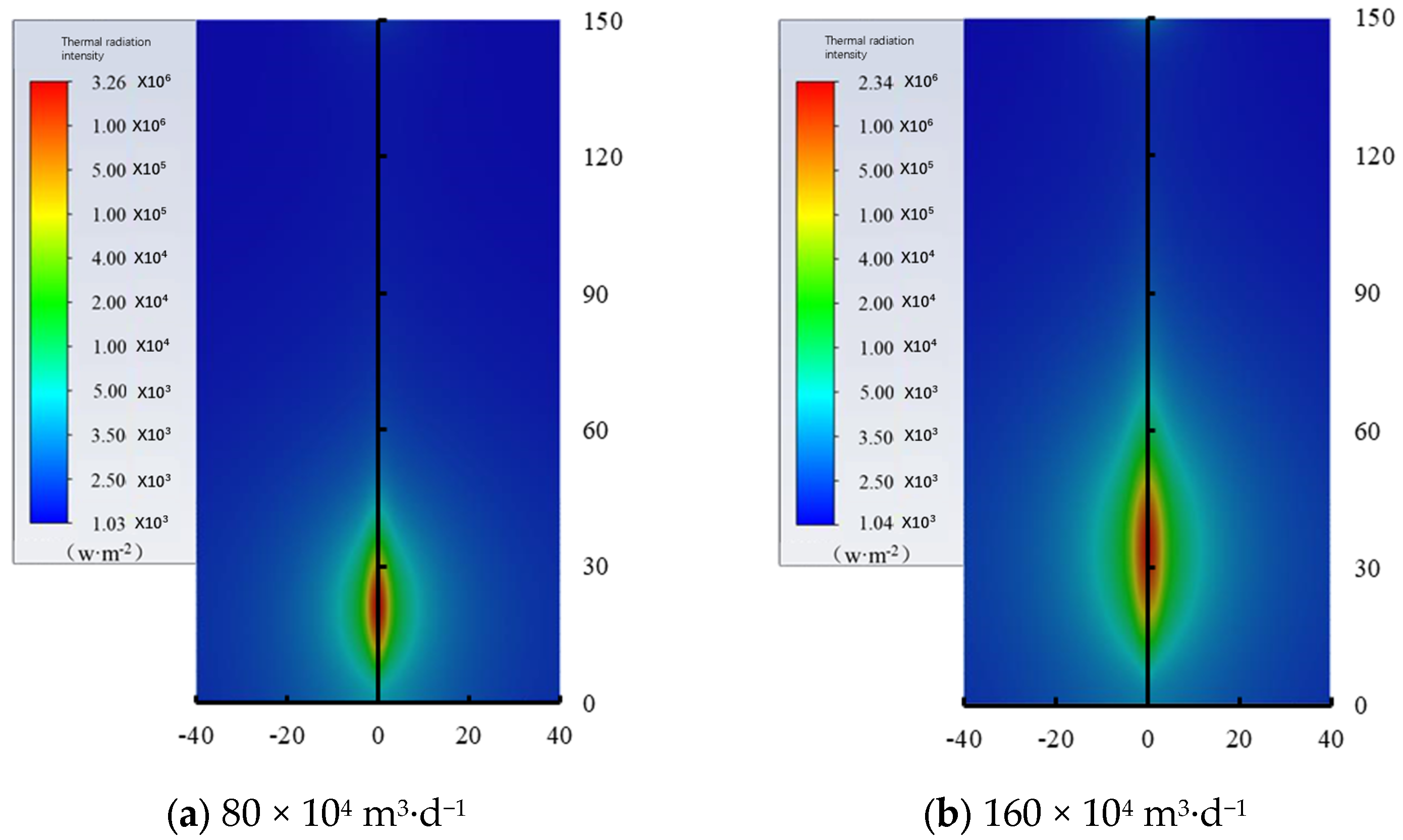
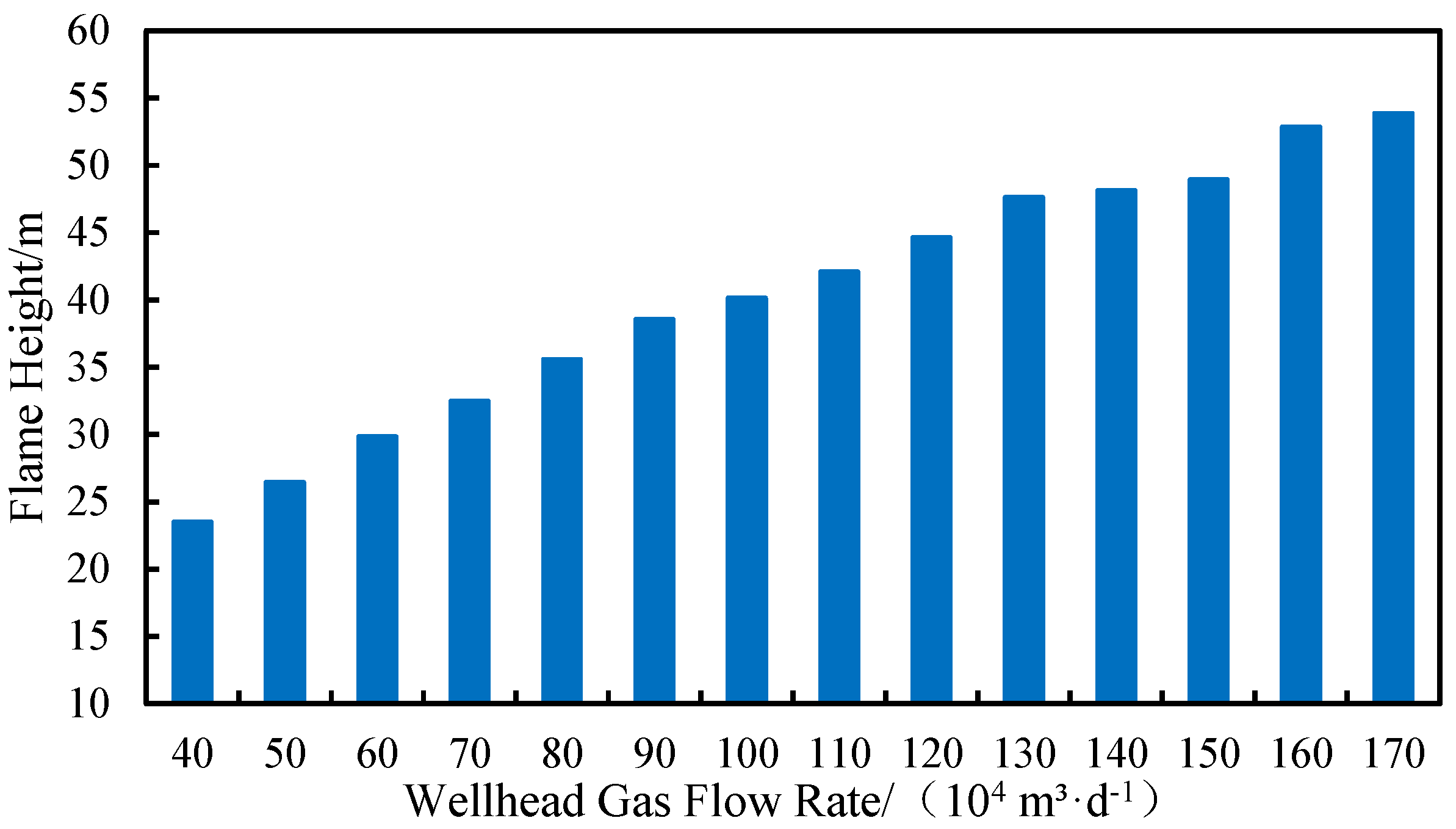


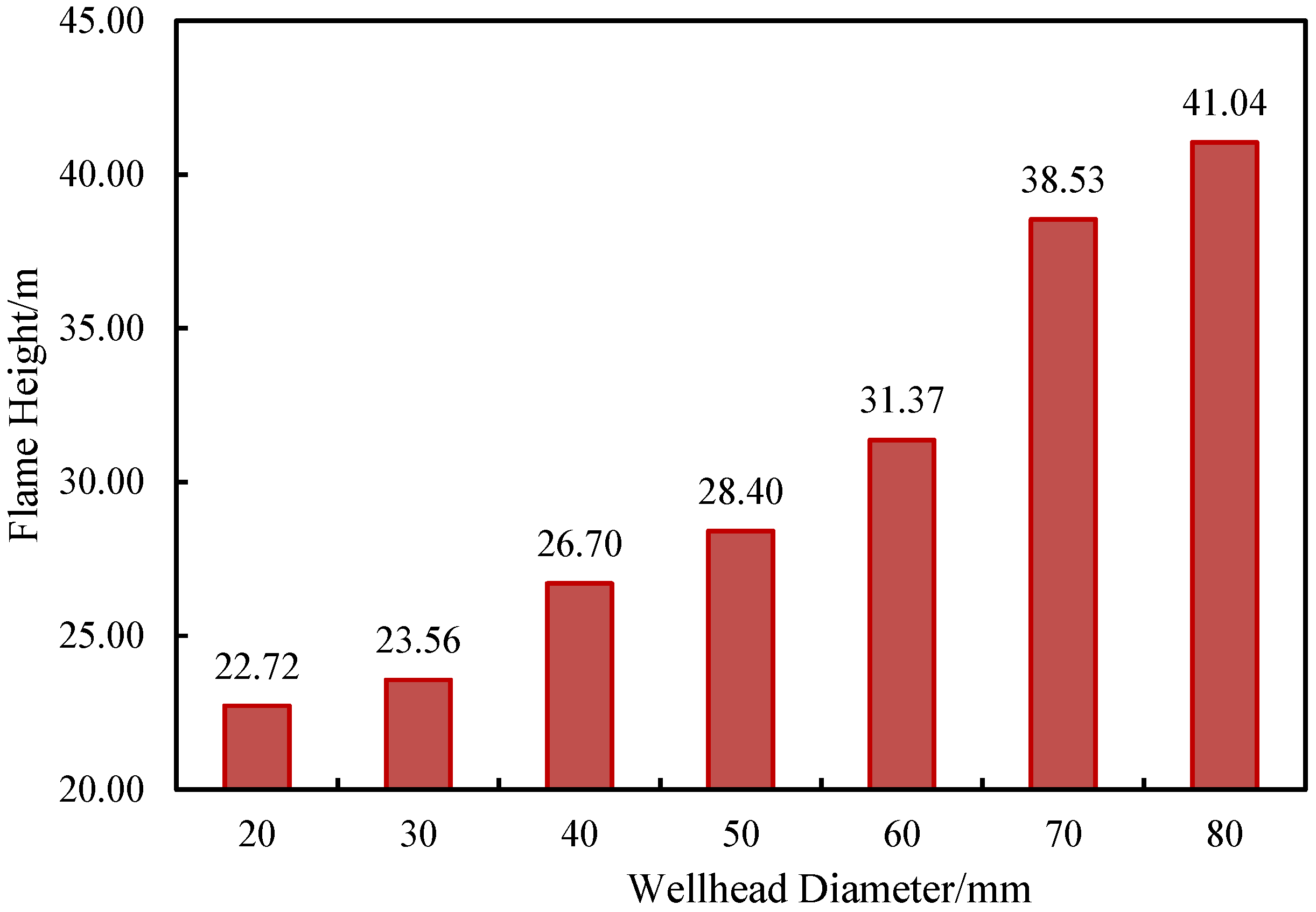


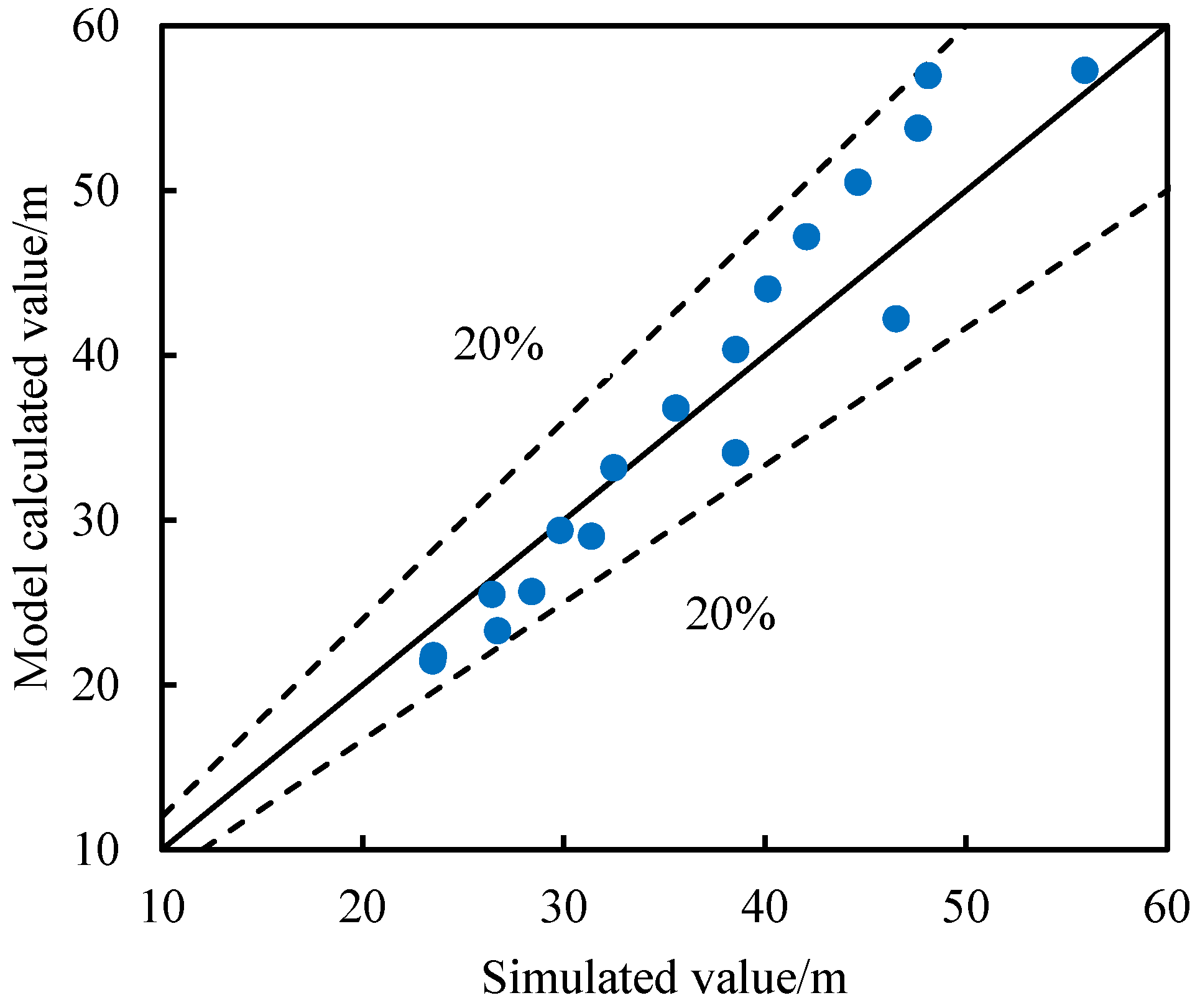
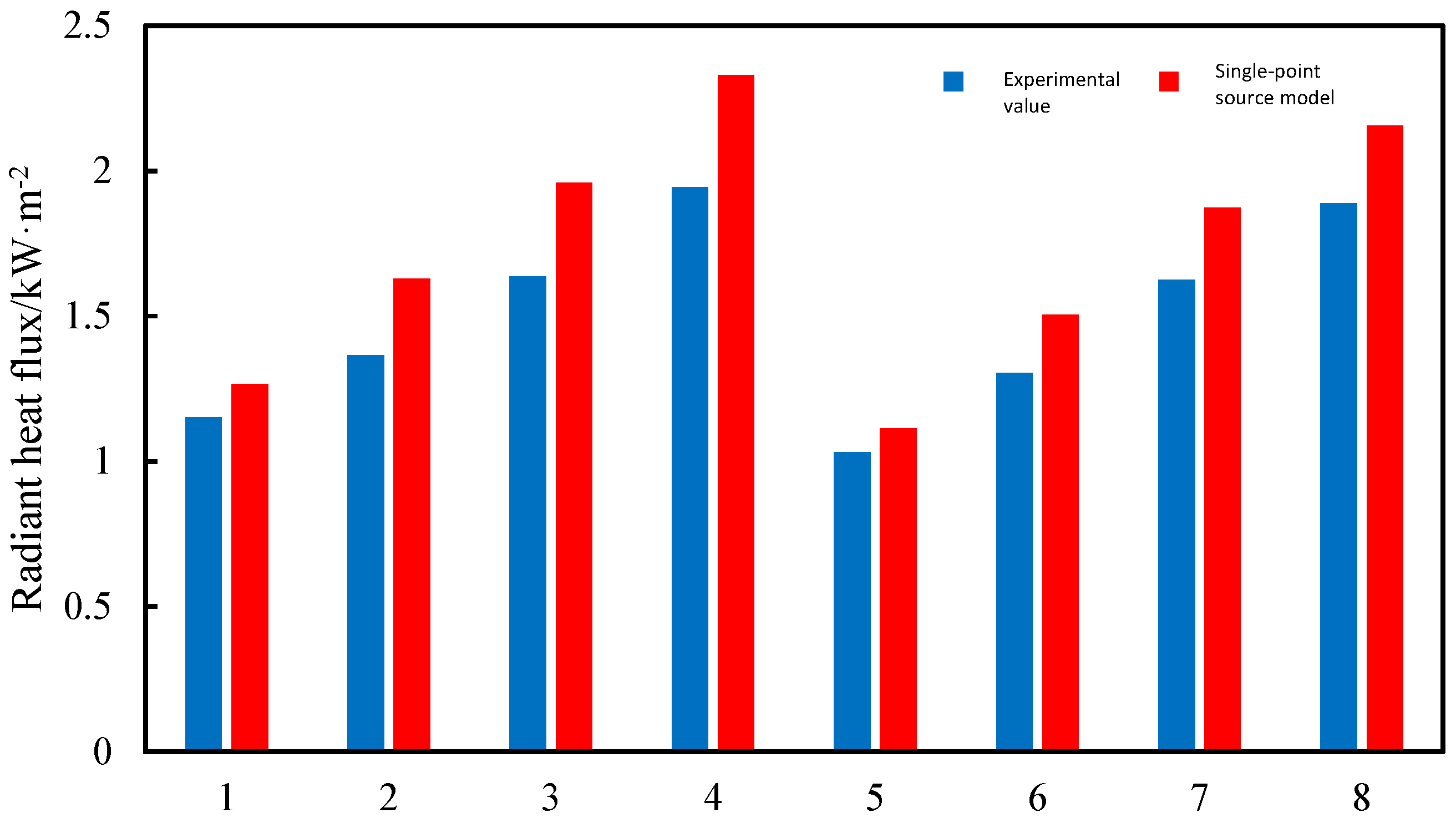
| Operating condition | 1 | 2 | 3 | 4 | 5 |
| Methane volumetric flow rate, m3·h−1 | 0.4 | 1.2 | 2.0 | 2.8 | 3.6 |
| Experimental Gas Volume/g·s−1 | Gas Volume Predicted Based on Radiation/g·s−1 | Error | Based on Flame Height Prediction of Gas Volume/g·s−1 | Error |
|---|---|---|---|---|
| 0.103 | 0.109 | 6.1% | 0.115 | 11.9% |
| 0.206 | 0.180 | 12.7% | 0.218 | 5.6% |
| 0.309 | 0.264 | 14.6% | 0.276 | 10.9% |
| 0.412 | 0.332 | 19.4% | 0.378 | 8.4% |
| 0.515 | 0.435 | 15.5% | 0.612 | 18.7% |
| 0.618 | 0.527 | 14.8% | 0.556 | 10.2% |
| 0.722 | 0.667 | 7.5% | 0.661 | 8.4% |
| 0.825 | 0.770 | 6.6% | 0.777 | 5.8% |
| 0.928 | 0.879 | 5.3% | 0.897 | 3.3% |
| 0.103 | 0.114 | 10.1% | 0.120 | 16.9% |
| 0.206 | 0.184 | 10.5% | 0.222 | 7.7% |
| 0.309 | 0.235 | 24.1% | 0.302 | 2.4% |
| mean error | 13.5% | 7.75% |
Disclaimer/Publisher’s Note: The statements, opinions and data contained in all publications are solely those of the individual author(s) and contributor(s) and not of MDPI and/or the editor(s). MDPI and/or the editor(s) disclaim responsibility for any injury to people or property resulting from any ideas, methods, instructions or products referred to in the content. |
© 2024 by the authors. Licensee MDPI, Basel, Switzerland. This article is an open access article distributed under the terms and conditions of the Creative Commons Attribution (CC BY) license (https://creativecommons.org/licenses/by/4.0/).
Share and Cite
Zhang, X.; Liu, X.; Huang, W.; Hu, J.; Du, Y.; Ge, D.; Sun, X. Gas-Flow-Rate Inversion Based on Experiments and Simulation of Flame Combustion Characteristics in a Drilling Blowout. Processes 2024, 12, 766. https://doi.org/10.3390/pr12040766
Zhang X, Liu X, Huang W, Hu J, Du Y, Ge D, Sun X. Gas-Flow-Rate Inversion Based on Experiments and Simulation of Flame Combustion Characteristics in a Drilling Blowout. Processes. 2024; 12(4):766. https://doi.org/10.3390/pr12040766
Chicago/Turabian StyleZhang, Xuliang, Xiao Liu, Wenxin Huang, Junjie Hu, Yonghong Du, Dongwei Ge, and Xiaohui Sun. 2024. "Gas-Flow-Rate Inversion Based on Experiments and Simulation of Flame Combustion Characteristics in a Drilling Blowout" Processes 12, no. 4: 766. https://doi.org/10.3390/pr12040766





